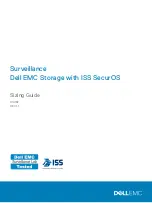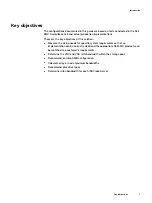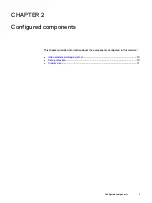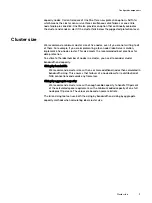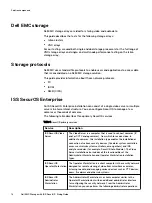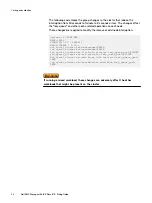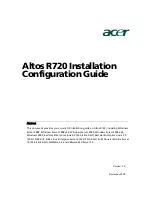
Isilon clustered storage system
Isilon NAS was designed and developed specifically for storing, managing, and
accessing digital content and other unstructured data.
An Isilon clustered storage system is composed of three or more nodes. Each node is a
self-contained, rack-mountable device that contains industry-standard hardware such
as disk drives, CPUs, memory, and network interfaces. These nodes are integrated
with the proprietary Isilon OneFS
™
operating system, which is a distributed networked
file system that unifies a cluster of nodes into a single shared resource.
Network interface card (NIC) aggregation can be used to reduce the possibility of
video loss from a cable pull, NIC failure, or switch port issue. Dell EMC recommends
NIC aggregation, also known as link aggregation, in an active/passive failover
configuration. This method transmits all data through the master port, which is the
first port in the aggregated link. If the master port is unavailable, the next active port
in an aggregated link takes over.
Data protection
OneFS does not rely on hardware-based RAID for data protection. The Isilon system
uses the Reed-Solomon algorithm for N+M protection with Forward Error Correction
(FEC).
Protection is applied at the file level, enabling the cluster to recover data quickly and
efficiently. Nodes, directories, and other metadata are protected at the same or a
higher level as the data blocks they reference. Since all data, metadata, and FEC
blocks are spread across multiple nodes, dedicated parity drives are not required. For
more information about Isilon data protection, see
Dell EMC Isilon OneFS: A Technical
Overview
.
Although cluster sizes as small as three nodes are possible, for surveillance
applications we recommend a minimum of five nodes. Sizing calculations need to
include a minimum free space calculation for proper cluster sizing. We recommend a
cluster size that enables a node to be removed while retaining a minimum of 10
percent free space in the remaining capacity. This cluster size ensures that node
removal and node failures have minimal or no impact on video ingestion.
The Isilon sizing tool provides an accurate calculation. You can find this tool at
https://isilon-sizing-tool.herokuapp.com
. Other sizing tools from video management
software (VMS) and camera vendors may also be used for sizing the necessary
bandwidth and storage capacity.
During our testing, we discovered that there might be some video loss when adding or
removing a node from the cluster. Isilon OneFS is a scale-out, single namespace,
clustered file system. To maintain coherency, OneFS implements a distributed lock
manager that marshals locks across all nodes in the cluster. When a node is added to
or removed from the cluster, all operations must be temporarily suspended until all
existing locks are rebalanced across the resulting node set. The system must then
recalculate the cluster write plan. The time that is required for this group change to
occur depends on the size of the cluster, individual node performance, and the cluster
workload.
Isilon protection with OneFS
New or upgraded clusters, starting with OneFS 7.2, provide a data protection level
that meets Dell EMC Isilon guidelines for mean time to data loss (MTTDL) for large
Configured components
10
Dell EMC Storage with ISS SecurOS
Sizing Guide
Summary of Contents for EMC Series
Page 1: ...Surveillance Dell EMC Storage with ISS SecurOS Sizing Guide H14192 REV 1 1 ...
Page 4: ...CONTENTS 4 Dell EMC Storage with ISS SecurOS Sizing Guide ...
Page 8: ...Introduction 8 Dell EMC Storage with ISS SecurOS Sizing Guide ...
Page 12: ...Configured components 12 Dell EMC Storage with ISS SecurOS Sizing Guide ...
Page 16: ...Solution components 16 Dell EMC Storage with ISS SecurOS Sizing Guide ...
Page 20: ...Sizing the solution 20 Dell EMC Storage with ISS SecurOS Sizing Guide ...

